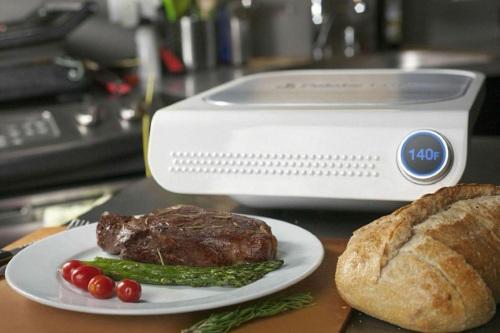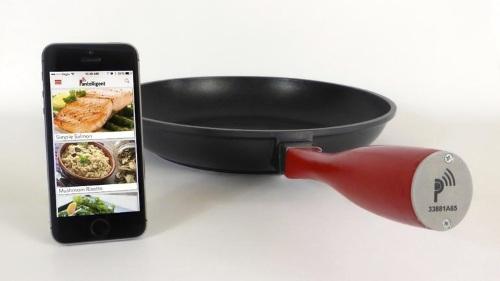Source: Louis Columbus, forbes, 29/7/2015, link: http://tinyurl.com/qhgjbfp
79% of enterprises surveyed have Internet of Things (IoT) initiatives in place today to better understand customers, products, the locations in which they do business with customers, or their supply chains.
45% of enterprises use IoT technologies to monitor production and distribution operations.
40% of Enterprises Are Growing Their Services Businesses With Internet of Things Initiatives.
Manufacturers expect Internet of Things initiatives to drive an average 27.1% revenue increase by 2018.
These and many other insights are from Tata Consulting Services’ TCS Global Trend Study 2015 – Internet of Things: The Complete Reimaginative Force (186 pp., PDF, opt-in) published earlier this week. You can find the methodology of the report here, and on page 173 of the report. A summarized report of survey demographics are provided here and also on pages 176 – 182. The TCS Global Trend study is based on interviews 795 executives from multinational enterprises operating in North America, Europe, Asia-Pacific and Latin America with average revenues of $22B. The TCS research team created four high-level categories of IoT business usage including premises monitoring, product monitoring, customer monitoring and supply chain monitoring.
Key take-aways from the study include the following:
Globally enterprises expect to increase revenues 16.3% between 2015 and 2018 using IoT initiatives, with North American companies projecting an average 18.1% revenue gain. Asia-Pacific companies expect a 17.9% revenue gain in the forecast period and Latin America, 17.8%.
Providing mobile apps to customers (46.5%), production and distribution operations to track product flow to customers (44.9%), digital sensors in products that send data to the company on how products are performing (25.2%) are the three leading uses of IoT technologies today. Digital sensors in distribution and supply chain locations (25.3%) and digital devices that are used for tracking customer usage (13.5%) are the remaining two of the top five ways enterprises are using IoT technologies today.
Travel, transportation and hospitality, industrial manufacturing and banking & financial services are the top three industries when ranked on average IoT spend per company in 2015. Travel, hospitality and transportation also leads IoT spend as a percentage of revenue (0.60%) across all thirteen industries surveyed.
Product monitoring (31.1%), customer monitoring (26.6%), supply chain monitoring (23.2%) and premises monitoring (19%) are the priorities enterprises are assigning to IoT initiatives. Product monitoring is dominated by manufacturers who sell products with prices from $1M to $10M and $10M and above. Customer monitoring includes fitness wearables and the subscription services offered to customers of these devices, providing them with insights into how they are progressing to health and fitness goals.
By 2020, IoT initiatives are projected to increase the services business (40.3%), drive greater revenue with product usage data (28.7%), and bypass entities in the distribution channel (22.8%).
Source: Louis Columbus, forbes, 29/7/2015, link: http://tinyurl.com/qhgjbfp
Posted by Hairol
Daily Activity Schedule
Thursday, 30 July 2015
Wednesday, 1 July 2015
IoT Invades the Kitchen
Source: Rick Merrit, eetimes, 2/3/2015, link: http://tinyurl.com/q94y2e9
An emerging Silicon Valley style of cuisine is on the rise. It should come as no surprise that it has a scientific bent and uses sensors, microcontrollers, wireless networks and mobile apps. Consider this your invite to a high-tech cook off in July.
A handful of startups are putting a new spin on the old stereotype of the Internet refrigerator that sends you a text when you need to buy milk. This time around the goals are more diverse, useful and tasty.
“I’m sick of discussions dominated by the Internet refrigerator,” said Jim Reich, a CTO of Palate Home Inc., a San Francisco startup making a connected precision grill for consumers. “Kitchen devices can have higher value than that because this is an area where you can make a big difference in people’s lives,” he said.
For its part, Palate Home is about to ship alpha units of its Palate Smart Grill, a device that aims to bring consumers the sous-vide experience offered in top restaurants. I had to look up sous vide to find out it’s a method of slow cooking food often in sealed bags in relatively low temperature water baths, popularized in the 1960’s.
According to the Palate Home Web site:
The best chefs have specialized tools for precision cooking, like combi ovens which cost tens of thousands of dollars and require a dedicated water line. We’ve optimized this precision-cooking technique for the home chef in an electric grill. [It requires] just one minute for setup, and one minute when you’re ready to eat. Powerful software and advanced sensors automatically adjust the cooking profile to give optimum results for your exact food.
Reich planted the idea in my head to organize a session on “Cooking with IoT” at the Embedded Systems Conference in Santa Clara where I am also helping organize a broader session on the Internet of Things.

The Palate Home Smart Grill promises sous-vide cooking with consumer ease.
Intelligent pans, connected scales

Pantelligent puts sensors in a frying pan controlled by a smartphone app.
There are plenty of potential panelists for our “Cooking with IoT” session.
For instance, at least three companies are already selling networked sous-vide devices. Sansaire is selling a $199 gadget, Nomiku has $299 and $129 versions — it claims the latter is the first to use WiFi (shipping in April) — and Anova Culinary has a $179 Bluetooth model and a $599 pro version that cooks up to eight pounds of food in 15 gallons of water.
If you want something simpler, you can try Pantelligent, an intelligent frying pan. It uses temperature sensors and an iPhone app filled with menus to monitor cooking of everything from your breakfast bacon to dinner scallops.
Pantelligent raised more than $83,000 from 464 backers in a Kickstarter campaign listed as a staff pick by the crowdfunding site. Chief executive Humberto Evans said the startup is working on fulfilling those orders and then ramping up for a broader market. Getting this far wasn’t easy, he said.
We are basically putting electronics somewhere they have not been before so a lot of weird things have come up. Early prototype pans literally exploded because we were dealing with glues and curing times of cement, so some pan bottoms flew off until we found out how to mount the sensors.
Pantelligent and Palate Home will both cook up a little something to sample at our Silicon Valley event in July along with another panelist or two TBD. As a lover of baked goods, I’m keeping my fingers crossed we can get a representative from Drop.
The Drop Kitchen Connected Scale has a wide range of uses with baking one of its strengths. The Bluetooth device is geared for use with iOS3 iPads with iPhone and Android apps in the works.
We’ve also reached out to The Orange Chef, maker of a connected scale that links to iPads and the Jawbone Up wristband. Both the Prep Pad and the Drop Scale aim to help promote and track healthy eating as well as making cooking easier.
“There will be quite a few products coming out in the next year or two that will change how we work in the kitchen,” said Evans of Pantelligent. “We all pretty much know each other, but we’ve never been in the same room,” he added.
Source: Rick Merrit, eetimes, 2/3/2015, link: http://tinyurl.com/q94y2e9
Posted by Hairol on 2/7/2015
An emerging Silicon Valley style of cuisine is on the rise. It should come as no surprise that it has a scientific bent and uses sensors, microcontrollers, wireless networks and mobile apps. Consider this your invite to a high-tech cook off in July.
A handful of startups are putting a new spin on the old stereotype of the Internet refrigerator that sends you a text when you need to buy milk. This time around the goals are more diverse, useful and tasty.
“I’m sick of discussions dominated by the Internet refrigerator,” said Jim Reich, a CTO of Palate Home Inc., a San Francisco startup making a connected precision grill for consumers. “Kitchen devices can have higher value than that because this is an area where you can make a big difference in people’s lives,” he said.
For its part, Palate Home is about to ship alpha units of its Palate Smart Grill, a device that aims to bring consumers the sous-vide experience offered in top restaurants. I had to look up sous vide to find out it’s a method of slow cooking food often in sealed bags in relatively low temperature water baths, popularized in the 1960’s.
According to the Palate Home Web site:
The best chefs have specialized tools for precision cooking, like combi ovens which cost tens of thousands of dollars and require a dedicated water line. We’ve optimized this precision-cooking technique for the home chef in an electric grill. [It requires] just one minute for setup, and one minute when you’re ready to eat. Powerful software and advanced sensors automatically adjust the cooking profile to give optimum results for your exact food.
Reich planted the idea in my head to organize a session on “Cooking with IoT” at the Embedded Systems Conference in Santa Clara where I am also helping organize a broader session on the Internet of Things.

The Palate Home Smart Grill promises sous-vide cooking with consumer ease.
Intelligent pans, connected scales

Pantelligent puts sensors in a frying pan controlled by a smartphone app.
There are plenty of potential panelists for our “Cooking with IoT” session.
For instance, at least three companies are already selling networked sous-vide devices. Sansaire is selling a $199 gadget, Nomiku has $299 and $129 versions — it claims the latter is the first to use WiFi (shipping in April) — and Anova Culinary has a $179 Bluetooth model and a $599 pro version that cooks up to eight pounds of food in 15 gallons of water.
If you want something simpler, you can try Pantelligent, an intelligent frying pan. It uses temperature sensors and an iPhone app filled with menus to monitor cooking of everything from your breakfast bacon to dinner scallops.
Pantelligent raised more than $83,000 from 464 backers in a Kickstarter campaign listed as a staff pick by the crowdfunding site. Chief executive Humberto Evans said the startup is working on fulfilling those orders and then ramping up for a broader market. Getting this far wasn’t easy, he said.
We are basically putting electronics somewhere they have not been before so a lot of weird things have come up. Early prototype pans literally exploded because we were dealing with glues and curing times of cement, so some pan bottoms flew off until we found out how to mount the sensors.
Pantelligent and Palate Home will both cook up a little something to sample at our Silicon Valley event in July along with another panelist or two TBD. As a lover of baked goods, I’m keeping my fingers crossed we can get a representative from Drop.
The Drop Kitchen Connected Scale has a wide range of uses with baking one of its strengths. The Bluetooth device is geared for use with iOS3 iPads with iPhone and Android apps in the works.
We’ve also reached out to The Orange Chef, maker of a connected scale that links to iPads and the Jawbone Up wristband. Both the Prep Pad and the Drop Scale aim to help promote and track healthy eating as well as making cooking easier.
“There will be quite a few products coming out in the next year or two that will change how we work in the kitchen,” said Evans of Pantelligent. “We all pretty much know each other, but we’ve never been in the same room,” he added.
Source: Rick Merrit, eetimes, 2/3/2015, link: http://tinyurl.com/q94y2e9
Posted by Hairol on 2/7/2015
Subscribe to:
Posts (Atom)